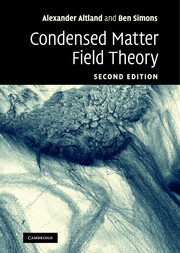Book contents
- Frontmatter
- Contents
- Preface
- 1 From particles to fields
- 2 Second quantization
- 3 Feynman path integral
- 4 Functional field integral
- 5 Perturbation theory
- 6 Broken symmetry and collective phenomena
- 7 Response functions
- 8 The renormalization group
- 9 Topology
- 10 Nonequilibrium (classical)
- 11 Nonequilibrium (quantum)
- Index
Preface
Published online by Cambridge University Press: 04 August 2010
- Frontmatter
- Contents
- Preface
- 1 From particles to fields
- 2 Second quantization
- 3 Feynman path integral
- 4 Functional field integral
- 5 Perturbation theory
- 6 Broken symmetry and collective phenomena
- 7 Response functions
- 8 The renormalization group
- 9 Topology
- 10 Nonequilibrium (classical)
- 11 Nonequilibrium (quantum)
- Index
Summary
In the past few decades, the field of quantum condensed matter physics has seen rapid and, at times, almost revolutionary development. Undoubtedly, the success of the field owes much to ground-breaking advances in experiment: already the controlled fabrication of phase coherent electron devices on the nanoscale is commonplace (if not yet routine), while the realization of ultra–cold atomic gases presents a new arena in which to explore strong interaction and condensation phenomena in Fermi and Bose systems. These, along with many other examples, have opened entirely new perspectives on the quantum physics of many-particle systems. Yet, important as it is, experimental progress alone does not, perhaps, fully explain the appeal of modern condensed matter physics. Indeed, in concert with these experimental developments, there has been a “quiet revolution” in condensed matter theory, which has seen phenomena in seemingly quite different systems united by common physical mechanisms. This relentless “unification” of condensed matter theory, which has drawn increasingly on the language of low-energy quantum field theory, betrays the astonishing degree of universality, not fully appreciated in the early literature.
On a truly microscopic level, all forms of quantum matter can be formulated as a many body Hamiltonian encoding the fundamental interactions of the constituent particles. However, in contrast with many other areas of physics, in practically all cases of interest in condensed matter the structure of this operator conveys as much information about the properties of the system as, say, the knowledge of the basic chemical constituents tells us about the behavior of a living organism! Rather, in the condensed matter environment, it has been a long-standing tenet that the degrees of freedom relevant to the low-energy properties of a system are very often not the microscopic.
- Type
- Chapter
- Information
- Condensed Matter Field Theory , pp. ix - xivPublisher: Cambridge University PressPrint publication year: 2010



